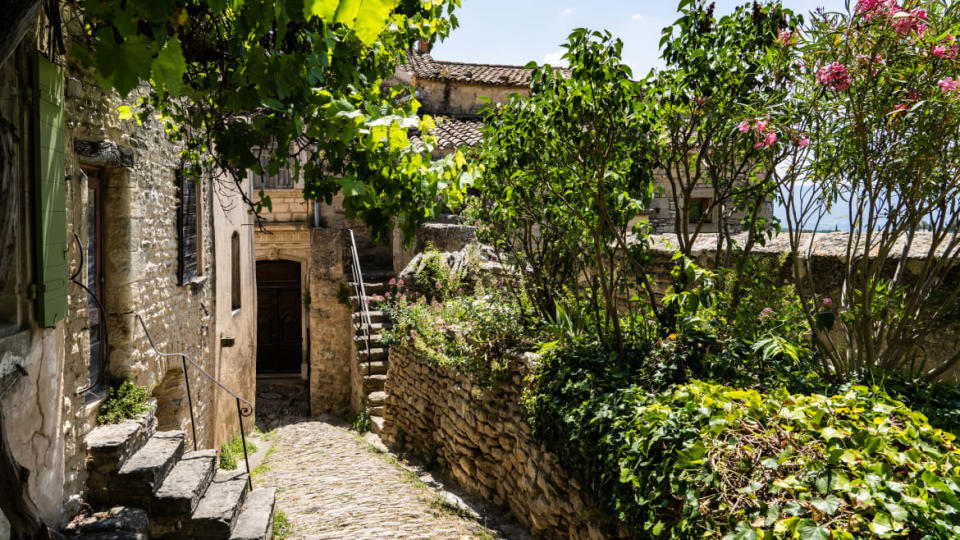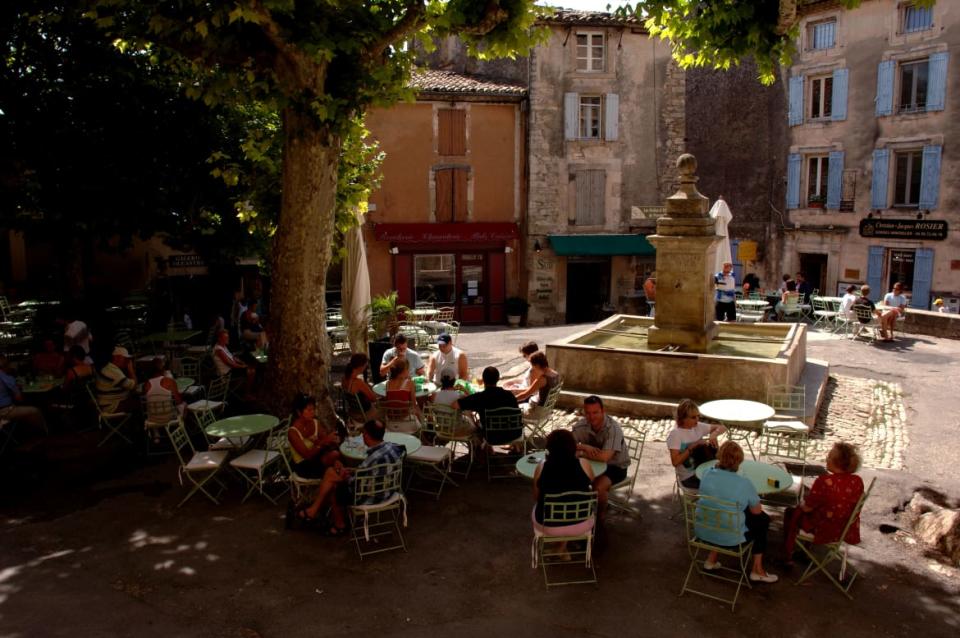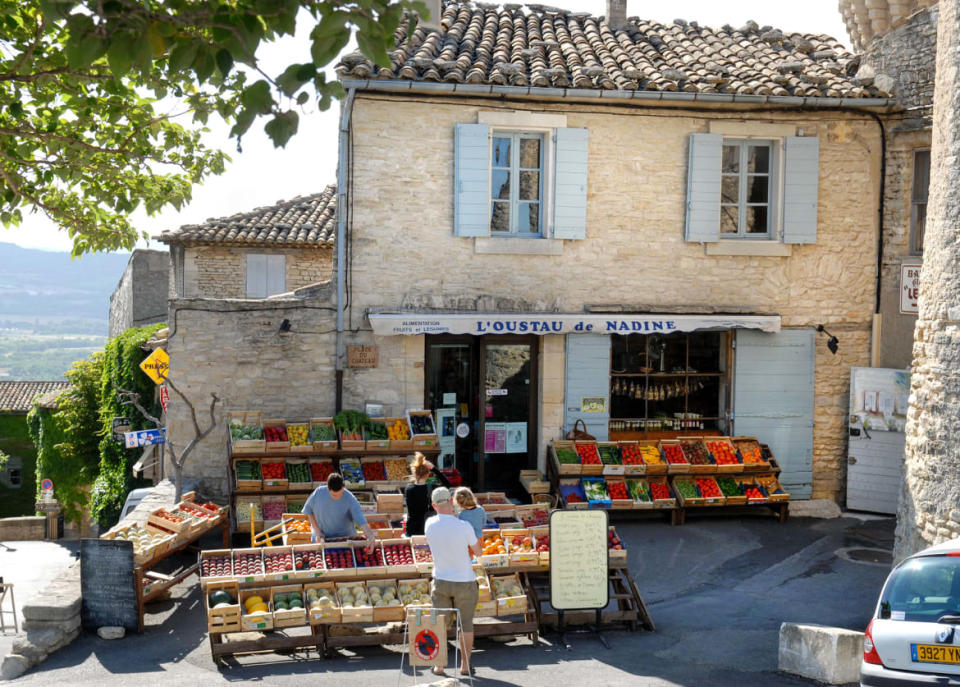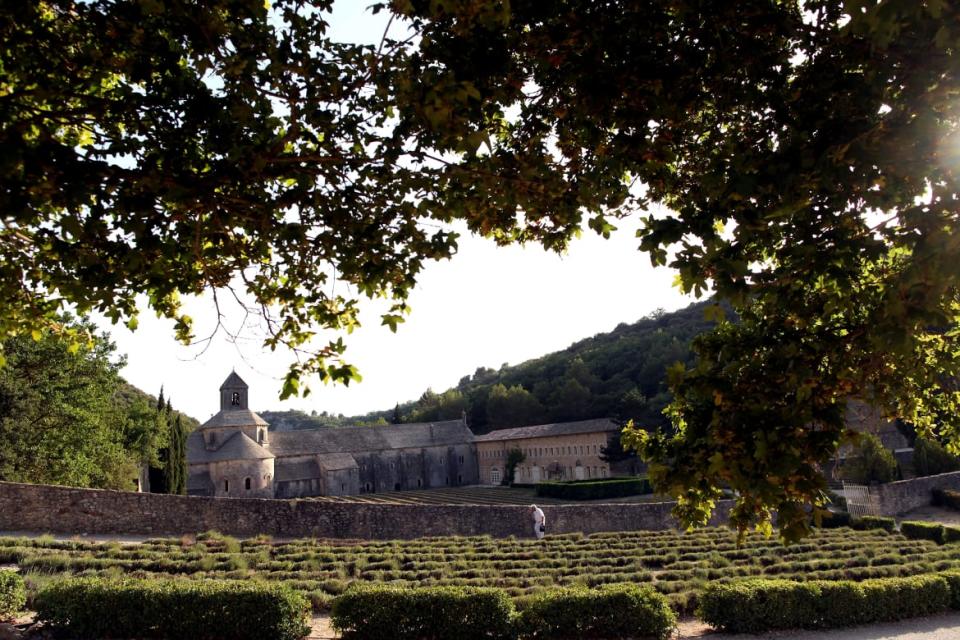Is France’s 'Most Beautiful Village’ Really All That?

During his presidency half a century ago, François Mitterrand had a discreet village hideaway built in Provence’s Luberon Valley, where he would spend holidays holed up with his secret second family.
In contrast to the 18th-century opulence of the Élysée Palace, the stone house was small and simple—more country cottage than luxury villa. It was at this cozy refuge that Mitterrand, his longtime mistress, Anne Pingeot, and later, their daughter Mazarine, would while away the scorching summer days, safe from the scrutiny of the press. So intent was the former president on keeping the little house a secret, that it was reportedly off-limits even to his bodyguards.
The clandestine presidential love nest was located in Gordes—a tiny perched village with stone houses the color of pale sand and a tangle of narrow, cobbled alleys leading up to a medieval chateau. The town was so off the radar that Mitterrand could freely stroll the streets without being found out. On the occasions villagers did recognize the head of state, (who sometimes strolled with his daughter in tow) they stayed mum.

Place du Château
“What’s funny is that François Mitterrand could walk around Gordes incognito with a simple hat and sunglasses,” French journalist and author Pierrick Geais told Madame Figaro. “People recognized him, asked him who the little girl was, but no one asked further questions.”
He added: “Today with social media, that would be impossible.”
He’s right, of course, but these days it isn’t only Twitter and Instagram that would hinder a French president’s attempt at duplicitous summertime dalliances. Since the days of Mitterrand’s presidency, the village of just 2,000 people has evolved from an unknown hamlet to one of the most sought-after stopovers in Provence. Indeed, few French towns have been the subject of as much media hype in recent years as Gordes, which makes regular appearances in “prettiest villages in France” listicles on both sides of the Atlantic.
Much of the village’s modern-day popularity can be traced back to the late Peter Mayle’s wildly popular love letter to the region, A Year in Provence. Although Mayle lived about a 20-minute drive away in neighboring Ménerbes, Gordes made a couple of appearances in his best-selling circa-1989 memoir. Since then, tourists began flocking to the area in droves in search of the sun-soaked landscapes and the bucolic, lavender-scented belle vie that the British writer evoked in the book.
Mazarine Pingeot still spends summers at the little house that her father built in Gordes, but these days she isn’t its only high-profile resident. Fugitive film auteur Roman Polanski is rumored to have a home in the village, and Ridley Scott, whose frothy comedy-drama based on Mayle’s eponymous novel A Good Year, owns a vineyard about eight miles to the south. So numerous are the rich and famous who descend on the village every summer, that Paris Match recently referred to Gordes as “the village of the jet-set chic.”
Earlier this year, Gordes snagged the number one spot in an article in Travel + Leisure’s ranking of the most beautiful small towns in the world, resulting in more global media coverage lauding its medieval architecture and, as one French lifestyle and culture site put it, “unrivaled charm.”
“A veritable postcard landscape,” was how France TV put it, crediting the town’s celebrity to narrow passageways, white stone houses, a chateau, and a church that are “emblematic of a typical Provençal village.”
Rather than igniting my curiosity, the myriad superlatives had me feeling slightly skeptical during the drive from Avignon to Gordes a few weeks ago. The “world’s most beautiful village,” is a lot to live up to, and I’m always a bit wary of destinations with loads of hype attached to them. Besides, any place that’s globally famous is certain to attract massive crowds. A stroll through Montmartre (where I live) or Venice at the height of tourist season is more claustrophobic than romantic, regardless of how many celebrities may be lurking within the tsunami of visitors.

"A classic village fruit and vegetable store with customers in Gordes.
I arrived in Avignon last month to brisk winds and gray skies, and as I made my way to the village, the Insta-worthy landscape of cypress trees and fields of vivid red poppies seemed slightly morose and out of place beneath an opaque canopy of clouds instead of the famed Provençal sunshine. Then things got even weirder.
“Something, something rocks and monkeys,” the driver announced as we approached Gordes, snapping me out of my reverie and filling me with confusion laced with a surge of adrenaline. I’ve had an unusual phobia of monkeys since childhood, and the idea of them anywhere near the car, let alone getting ready to hurl rocks in our direction, was enough for my fight or flight response to kick into high gear.
“The monkey rock,” he said again, gesturing to our left where, thank God, a line of phone-wielding tourists, not primates, stood gathered before a craggy lookout. From a distance, the row of heads peering over the boulders did evoke curious simians, and it was easy to see how the scenic spot got its name. What they didn’t know, he explained, was that there was another lesser-known lookout nearby that not only had better views but was free of crowds.
He was right. The other lookout, situated a little further down from the rocher des singes was deserted, which allowed me to take in my first views of the town without having to worry about being jostled by fellow visitors vying for the perfect shot. And even though I had seen pictures of the village, the sight of the imposing, rocky hill with its nautilus-shaped maze of stone houses and fortified castle at the summit had a wow-factor that photos simply can’t capture.
The “monkey rock” and the “locals’ lookout,” I would later discover, are one of many dichotomies in a village that has experienced myriad incarnations over the centuries and possesses an impressive and indefatigable resilience. Whatever history has thrown at it—invading Huguenots, earthquakes, or Nazi bombardments—Gordes has managed to rise from the proverbial ashes and begin anew.
“In summer, there are two Gordes, just like there are two Provences,” Le Figaro observed some years ago, referring to the contrast between the cool mornings and the searing midday heat. But there are also two Gordes throughout the year (in winter, the village is reportedly deserted) and throughout history, and I was also struck by how a place that’s currently lauded for its natural beauty and serenity has a past rooted in centuries of tumult.
When I arrived in town, an annual literary festival was winding down and school holidays were in full swing, so the streets were busy but not overwhelmingly so. Pedestrians walked in single file along a narrow sidewalk lined with stone structures the color of sun-bleached bone, and a tent had been set up in front of the chateau that was manned by writers flanked by stacks of books ready for signing.

A view of the Abbey of Senanque in Gordes, Provence, France.
Gordes dates back to Roman times, but the village as we know it emerged during the 11th century when its chateau and fortifications were built. The neighboring Abbey de Senanque was constructed about 100 years later, but its low-lying position was a disadvantage during the brutal Wars of Religion that raged in the latter part of the 16th century during which the Huguenots raided the monastery and murdered many of the monks. Heavily fortified Gordes, however, resisted the assault from its strategic hilltop position as it had resisted other aggressions since its inception. The chateau underwent a Renaissance-style remodel in the early-1500s, and when it’s not hosting readings from the French literary set, it houses the town hall and an exhibition space dedicated to works by contemporary 20th-century artists (and onetime residents of Gordes) Pol Mara and Victor Vasarely.
Airelles Gordes, La Bastide served as my home during my stay, and the property would be easy to miss were it not for an unobtrusive sign attached to the façade and a large wooden door that reminded me of a set piece from a Shakespearean drama. Perched on medieval ramparts, the core of the building dates back to the 16th century, but the rest was added on some two-hundred years later. The Christophe Tollemer-designed interior has an elegant, country manor-style ambiance and is filled with 18th-century furnishings that were sourced from the antique markets at nearby l’Isle-sur-la Sorgue.
“Like a fairytale” seems so cliched, but there are aspects of the hotel that nonetheless seem to have tumbled out of the pages of a sumptuous fable. Maybe it’s the somewhat silly yet whimsical 18th-century-style attire of the attentive staff, who bustled about like a coterie of fairy godmothers (and godfathers), or my spacious room with the paisley wallcoverings, ridiculously comfortable bed, and Alice in Wonderland-esque assortment sweet treats waiting on the coffee table, including blue and tan Ladurée macarons that matched the color scheme of the sofa. Or maybe it was the vast breakfast buffet that spilled across two rooms and had enough cakes, pastries, and crepes to rival the sugar-laden daydreams of my childhood.
The walls are adorned with stern-faced 18th-century oil portraits whose eyes seemed to follow me sometimes, and plush animal heads are mounted trophy-like along the corridor leading to the kids club as though a trigger-happy hunter had gone on a safari at FAO Schwarz. This kind of slightly zany elegance adds a touch of playfulness to the experience—almost like you’re visiting the summer home of a sophisticated, yet eccentric aunt—and after a long day of metros, trains, and car trips, it’s easy to sink into a comfy couch at the parlor-like bar and unwind over tea (or something stronger) in front of the fire, which is exactly what I did.
It’s the views that take the enchanted mansion ambiance up a notch, though, and whether I was watching the sunrise from my room or feasting on modern Provençal delicacies on the terrace of Clover Gordes, the sight of the sprawling Luberon Valley dotted with pointy cypress trees and old stone buildings was nothing short of cinematically beautiful. The Emily in Paris production designers apparently felt similarly, because Clover Gordes and its scenic terrace stood in for the L'Esprit de Luberon restaurant in season 3 of the popular series.
A less chic, but historically rich spot to take in the view is at the Cercle Républicain—an unassuming cafe-bar that’s a quick walk from the hotel and was a hotbed for covert activity decades before Mitterrand’s secret house existed. It was founded in 1912—just three years after a powerful earthquake struck the region and damaged or destroyed numerous buildings—and was one of thousands of its kind throughout the country.
These members-only establishments initially functioned as local meeting spots to protect the values of the French Republic from the threat of the church and any royalists who were still pining for the days of the court of Versailles. In the early 1940s, when France was facing a new and more frightening menace, Resistance members would gather here and collude against the Nazi occupation. The Cercle Républicain in Gordes is one of just a handful left in France and remains a favorite local haunt.
When I walked in, a 60-something woman behind the bar was shouting at an older gentleman to “shut your mouth” in a tone that suggested that this kind of banter between the proprietors and local patrons was fairly commonplace. A crude sign dangling near the entrance listed the current president, vice-president, and treasurer, and as well as the fee for daily and annual membership cards—20 centimes and €6 respectively—but the policy didn’t seem to be heavily enforced because the brusque madame behind the counter just took my drink order without asking any questions. In a sparsely-decorated back room, a young man was strumming a guitar and the small terrace outside was crowded with people sipping late-afternoon beers or glasses of rosé and gazing out at the sprawling Luberon Valley.
When French Resistance fighters weren’t plotting against the Nazis over beers, they were making use of the underground tunnels at the Caves du Palais Saint Firmin. Just two minutes from the Cercle Républicain, this fascinating warren of underground cellars dates back to the Middle Ages, and was discovered in the late-1970s during the restoration of a Renaissance-era mansion.
Apparently, even back in the medieval era there were two Gordes—one above ground and one below. While the inhabitants lived aboveground, business and commerce were conducted underground. The caves protected the workers from the summer heat and the violent mistral winds, and remnants of Middle Ages-era industry, including an olive oil press, a cistern, and grain silos, are on display in the cool, dimly-lit spaces. Bullets believed to have belonged to Resistance members were discovered in the tunnels, but the cave network was used as a hiding place centuries earlier during the bloody Waldensian wars when residents took refuge there.
I knew that Gordes was tiny, but it took me circling it twice to grasp just how small the town center is. Aside from the chateau, other main sites include the Romanesque-style Eglise Saint-Firmin with its 18th-century woodwork and colorful murals in varying shades of periwinkle and shell pink, as well as the Place Genty Pantaly and its 14th-century fountain.
During one of my first treks through town, I passed tourist-centric boutiques selling linen dresses, perfumed soaps, and bright pottery, but also more offbeat storefronts, including L'Alchimiste et La Fée—an incense-scented esoteric shop whose collection of amethyst nightlights, sage bundles, tarot cards seemed straight out of Berkeley, California in the ‘70s. It was the collection of artisanal booze, including rum and pastis infused with flavors like cayenne ginger and lavender, however, that caught my eye more than the woo-woo ephemera.
On the other side of the street stood a clinic offering kinesiology, energy treatments, and something called pose minerale that I think has something to do with healing crystals. The California vibe continued as I made my way through the tangle of slippery, cobbled streets past an organic wine shop and a juice bar. Wellness is big in Provence, and Gordes is no exception. A cursory Google search reveals about a dozen massage and wellness centers in the village, and that’s not including the spacious spa at Airelles Gordes, La Bastide that was inspired by the Abbaye de Sénaque—think stone archways and heavy, wooden ceiling beams—and offers everything from customizable massages to high-tech hydrating facials using LED light therapy.
The most intriguing storefront (if you could even call it that) was situated on the edge of the town center, and featured a crude sign tacked onto a weathered wooden tour offering truffles for sale directly from a local producer with a cell number below it. The windows were barred shut and there was no other advertising. I cast a wary glance at the empty street. Were these illicit truffle dealers? Or maybe it was an outpost for members of the truffle mafia, which, by the way, is a thing in France.
Whatever was going on, the sign sparked a craving for the precious fungus, which fortunately was available in sauce form and bottled in neat jars when I stopped by the weekly market later in my stay. If you miss market day, another spot to pick up local delicacies is at Vanille & Lilas, which is owned by Airelles Gordes and is stocked with upscale artisanal products, including delectable, high-end olive oils produced at the Airelles hotel group’s Château d’Estoublon estate in Fontvieille that’s a bit more than hour away from Gordes.
Because Gordes was such a French Resistance hub, the Gestapo eventually retaliated, bombing the village and executing over a dozen residents. So well-known were the village’s anti-Nazi exploits that three years after the war, the French government presented Gordes with a prestigious Croix de Guerre medal for being “one of the most active centers of German Resistance under Occupation.”
The war may have been over, but Gordes was dying. Over the years, the village’s inhabitants had been leaving the hilltop town in droves, and in the months after the war it was all but abandoned. This changed from the end of the ‘40s through the early ‘60s when modern artists like Marc Chagall, Victor Vasarely, and André Lhote discovered the village and became seduced by its landscape and natural light.
“Whether at Senanque Abbey or in the most humble dwelling in Gordes, a small square window in a large wall lets in so much light…” Vasarely recalled in 1964. “This same opening, viewed from the outside, becomes an ethereal and unfathomable black cube. The villages and towns of the South, blasted by an implacable sun, were my introduction to the contradictions of perspective.”
The current housing market in Gordes is off-limits to most artists without trust funds, but some members of the creative set have been living and working here long before the village’s jet-set chic days and were savvy enough to hold onto their property.
Jean-Max Toubeau grew up in Gordes at a time when running water and electricity were scarce and Marc Chagall would regularly drop by the family home to visit his father, who was also an artist. Born in 1945, the painter currently divides his time between Paris and Gordes, and has witnessed the village go from peasant village to global tourist hub.
“During my childhood, there were two types of individuals in Gordes,” he recalled. “Artists and farmers. Today it’s wealthy people and tourists.”
Indeed, in recent decades the town has been beset with a different kind of invasion. These interlopers come bearing money rather than medieval weapons, but their sheer numbers can annoy the residents and put a strain on the village’s celebrated tranquility.
“Nightmarish, hellish, and insane,” were among the words several people used to describe the crush of tourists that descend on Gordes every July and August when I asked about them, and my mind turned again to Montmartre during high season. France Info reported recently that the number of daily visitors can top 10,000, which is horrifying given the town’s small size. Add the blistering summer heat to the equation and “hellish” seems about accurate.
“There have always been a lot of people,” Pierre-François Lamiraud, a Paris-based singer and actor in his 30s, who has been visiting the village for the past decade, told me. “But every year there’s more.”
He believes that the influx of wealthy retirees buying second homes here combined with the throngs of tourists, some of whom even send drones buzzing over local properties, have caused the village to lose a bit of its authenticity in a similar way that Montmartre’s artist colony past at the iconic Place du Tertre has been overshadowed by pricey real estate and annual swarms of visitors.
Despite this, he is still drawn to Gordes’ natural beauty and “quality of life,” recounting the open-air concerts and private parties that are held behind high garden walls during the summer months. One time, he told me, a group of revelers even hauled a piano out onto a terrace for an impromptu recital.
The local action, he added, happens farther down the hill and away from the main sites in the village.
A representative at the Luberon’s tourist office seemed to agree, telling me that it wasn’t a question of too many visitors, but rather the timing of their travels and a tendency to cluster around the same landmarks.
“The major problem is that most of the tourists come at the same time, which creates a mass effect,” Bianca Ogel of Destination Luberon said in an email, explaining that autumn and spring were a better bet in terms of weather and crowds. Visits, she added, should be spread out to include the late-afternoon and the early morning, and visitors should take the time to “get lost in the village.”
“Most of them stay in the upper levels of the village, while the lower part is just as charming and practically empty of tourists.”
On the day before I left, I took a final early-evening walk around the town. The shops were closing up for the day, and as I ventured further down the hillside the narrow streets became increasingly empty. High stone walls hid most of the houses from view, and my mind turned to illicit meetings and furtive music recitals underway in private gardens.
As the shadows grew longer and the blasts of the mistral got cooler, the alleys became even quieter, and it was easy to imagine a band of revolutionaries lurking behind a blind turn or a philandering politician peering out from behind a large straw hat. It was as though, for a few brief minutes, I got a glimpse of the other side of Gordes; the Gordes that for centuries has served as a refuge, an inspiration, and a protector of secrets.
Get the Daily Beast's biggest scoops and scandals delivered right to your inbox. Sign up now.
Stay informed and gain unlimited access to the Daily Beast's unmatched reporting. Subscribe now.

 Yahoo Sports
Yahoo Sports 